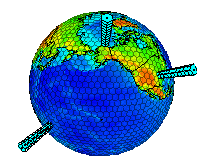
 |
SCM Description |
|
The SCM is a diagnostic model resembling a single vertical column of a 3-dimensional general circulation model (GCM). The SCM contains a full set of parameterizations of subgrid physical processes that are normally found in a modern GCM and is applied at a specific site having a horizontal extent typical of a GCM grid cell. Since the model is one-dimensional, the advective terms in the budget equations must be specified from observations or operational numerical weather prediction analyses. In these experiments the SCM is forced with data from the Reanalysis 1 version of the NCEP Global Spectral Model (GSM). The SCM is run at three locations coinciding with the ARM Cloud and Radiation Testbed Sites located in the U.S. Southern Great Plains (SGP), Tropical Western Pacific (TWP) and the North Slope of Alaska (NSA). The horizontal advective forcing for the SCM is obtained from the GSM gridcell nearest to each of these three locations. Additionally, the SCM uses the surface latent and sensible heat fluxes and the surface temperatures produced by the GSM. We are using the SCM to investigate the sensitivity of cloud-radiation interactions to various cloud and cumulus convection parameterizations. Other modeling groups use SCMs as testbeds to develop new parameterizations. A relatively recent reference which describes the SCM in detail is Randall et al (1996: Journal of Climate, vol 9, pages 1683-1697). |